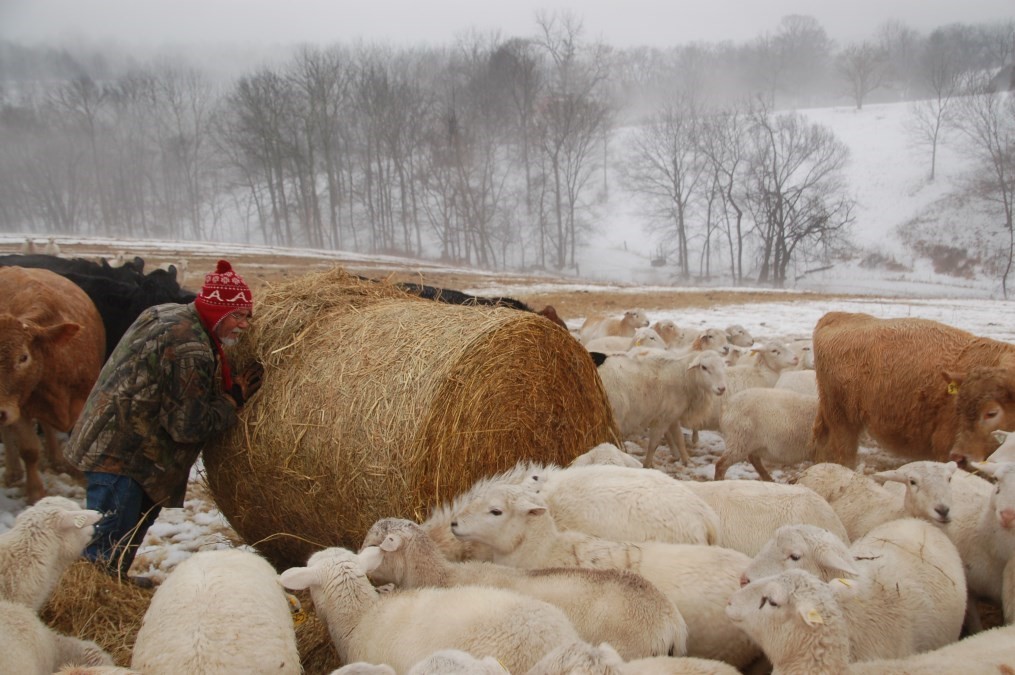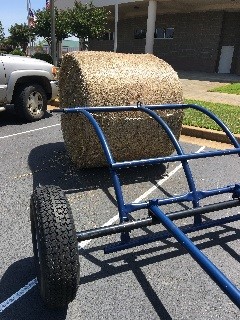
Timely Tips – January – Forage
Planning: Winter is a great time to reflect on our management this past year and what changes we plan for the upcoming year. Stocking rate, feeding, sacrifice area, culling, grazing management, seeding, etc.
Stocking rate has the biggest impact on resource management and our bottom line. In this high rainfall area we typically think 1 animal unit (AU, 1,000 lb. cow with up to a 300 lb. calf) per 2 acres and this is where my operation is currently stocked with 90 to 120 days of hay feeding. This is too high and too many days of hay feeding, Greg Halich, University of KY Agriculture Economist, recently estimated with current cattle prices and moderate to low. Low cow cost operators can reasonably feed 60 days. Acres per animal unit depends on lots of variables: soil fertility, soil type, residual grazing height, rotation days of grass recovery, and lots of other factors. Very few farms: have optimum soil fertility, manage to not graze below minimum residual heights (e.g. 3” for tall fescue), provide time for grass to recover and regrow. Most excellent grazers that feed no hay are stocked at 1 AU per 4 or 5 acres and rotate every day or more often. A reasonable stocking rate for most operations that is 3 acres per animal unit. Remember that stockpiled tall fescue is better than hay all the way till March. Sometimes you have to take a step back to make two steps forward.
Feeding strategies for profit, ultimately don’t feed hay in one location the same way year to year or even in wet and dry times. Like all grazing management it is best to not lock into one strategy. If it is wet and soil is prone to compaction consider feeding hay in rings. If you have a hay manger to feed out of or a hay feeding pad this is the time to use them. When the ground is dry or frozen it is a good time to unroll hay daily. Feeding hay in rings in combination with unrolling at the same time typically doesn’t work so well because stock don’t clean up the unrolled hay soon enough. Best areas to target when feeding hay are fields with low fertility or lots of undesirable forage. Each ton of hay contains 60-13-48 of N-P2O5-K2O. Unrolling hay on a low fertility field in combination with liming i can change it to a high producing field in about 3 years.
Equipment to consider, not an endorsement of vendors: Hay B Gone, hay unroller can be pulled with a UTV; Spin off, a hydraulic driven hay unroller for the tractor that spins both ways and works well for flatter terrain; hay saver feeder is good for permanent hay feeding site but too heavy for rotational feeding and there are some reports of incidence of calves being hung in them. Plastic hay rings very light but hold up well.
Convenience is feeding near the barn, it is easy, less traffic compaction by equipment but poor utilization of nutrients in the hay and manure. Expect weeds like spiny amaranth on land with excessive nutrients.

Unrolling hay, takes some management and requires being done daily. If done correctly, Texas A & M found that one third less hay was needed. Other studies have shown as much as half of the hay can be wasted (it’s not waste if it returns to the soil) if not done timely/properly. Poor quality hay is more prone to avoidance and if your unrolled hay gets rained on it is less palatable. Advantages of unrolling hay is more stock have access to hay and calves are less likely to be stepped on, lower cost than lots of hay rings and manure, biomass and trampling are strategically placed. Typically don’t need to reseed after unrolling hay. Caution any form of hay feeding can bring in weed seeds.
Bale Grazing, is where you spread bales across a paddock in the fall or winter and move a temporary wire to allow access to more hay. Ideally you would move hay rings to control loss. Round rolls should be a minimum of 30’ apart and most likely you will need to seed the area after feeding so feeding them in somewhat of a straight line make reseeding easier. You can also creep bale graze allowing calves access to higher quality hay under a high electric wire.
Places not to feed: on the creek or other water areas unless you are trying to seal a pond. Don’t store hay or feed hay in the drip line of trees unless you are trying to control some weeds. Nutrients from the hay and manure are best spread across the pasture by the animals. Don’t feed on waterways unless it is already gullied and you have a plan to seed it soon after feeding. Also avoid feeding in depressions or near sinkholes.
Sacrifice areas, not many farms have good designated sacrifice areas. These areas are for use when pastures are grazed down to minimum recommended heights. I used to think it was ok to graze down to 2” height in winter but in order to optimize grass production maintain 3” or more height on pastures. Location of a sacrifice area: fence off an area that is high on the landscape centrally located (the hub of the operation) and an area that doesn’t have any sensitive areas like water bodies, drainageways or karst areas. If it does have sensitive areas NRCS recommends fencing those areas out. If sensitive areas are present it is best to have a 35’ wide or wider vegetative filter where water enters these areas. Single wire electric temporary fence can be used to accomplish all this.
Grazing management: Continue to feed hay into the spring till grass is 6-8” tall this will allow the grass to become stronger and set you up for grazing an extended time. Ideally some fall grown grass mixed with springs lush grass is best. If grass gets ahead of you in the spring defer grazing some fields till August, it is not likely to be high quality in August however it will return that biomass to the ground at a time when cool season grasses typically break dormancy allowing you to grow additional stockpiled grass for winter.
Manage minimum grazing heights of 3- 4” or higher for cool season grasses
Allow plants to recover growing to 8” or taller before re-grazing.
Additional management strategies:
- Limit exposure to hay to reduce consumption and waste however monitor cattle body condition score, much of the hay is low quality
- Unroll hay daily for more animal access and to distribute animal impact and manure where you desire
- Develop more paddocks to stretch forage supplies next year
- Plant warm season forage
- Stockpile grass as a reserve for drought and winter.
- UT Extension recommendations: http://utbeef.com/
Next month’s timely tips will be on frost seeding but if you need to order seed consider this:
Common recommendation:
Species up to pounds/acre
White clover 2
Red clover 4
Annual lespedeza 8 on less productive soil
Optional additions
Forage turnips 1
Arrowleaf clover 1
Hairy vetch 2 ideally sown in the fall but will improve diversity
Annual ryegrass 2 not recommended by university forage agronomist too competitive
Matua or Persister
Bromegrass 2 ideally sown in the fall but establishes easy particularly adapted to high fertility shady areas